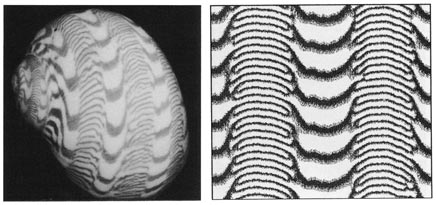
This Article From Issue
September-October 2001
Volume 89, Number 5
DOI: 10.1511/2001.34.0
Signs of Life: How Complexity Pervades Biology. Ricard Solé and Brian Goodwin. xii + 322 pp. Basic Books, 2000. $30.
Martin Luther once quipped that "The human heart is like a ship on a stormy sea driven about by winds blowing from all four corners of heaven." Although he certainly wasn't thinking in terms of complexity, his remarks seem to have a certain fundamental truth about them. Nonexperts might be forgiven for assuming that a healthy person has a strong, regular heartbeat and that someone with cardiac disease has an irregular one. Surprisingly, as Ricard Solé and Brian Goodwin explain in Signs of Life, the reverse is true: The intervals between heartbeats show more irregularity and unpredictability in healthy than in unhealthy hearts. In the healthy, the pattern of variation is fractal—that is, it is "self-similar," in that healthy hearts exhibit the same overall pattern of variation at whatever timescale you analyze. The danger signals are periodic behavior—a regular cycle of increasing and decreasing interbeat intervals—or little variation at all. Signs of Life is full of such fascinating and sometimes counterintuitive examples.

From Signs of Life.
Solé and Goodwin take us on a whirlwind tour of complexity in biology. Complexity is never explicitly defined, although the authors do hint that it lies somewhere between order (regularity) and disorder (chaos). Instead, they emphasize and illustrate the different characteristics of biological complexity. As they delve into what may at first appear to be very disparate subjects—such as brains, ants and food webs—the same phenomena arise time and time again.
Perhaps the most pervasive theme is that of phase transitions. These are sharp changes in behavior of a system when it crosses a threshold value for some important parameter. For instance, imagine that the density of trees in a forest could be increased. (This forest is in a grid; each cell either contains a single tree or is empty.) At each density, a tree is randomly chosen and set alight; if burning trees can ignite only their immediate neighbors, how much of the forest will burn? Below a critical density of 0.5, very little indeed of the forest burns. But at densities even slightly above this threshold, clusters of trees start to link up with other clusters, so that the fire can spread far from its initial starting point, and almost all of the forest burns. Solé and Goodwin argue that such sensitive behavior is extremely common in biology, in systems that are poised at the "edge of chaos."
This notion, like most of the material in this book, is not new; many of these ideas, concepts and examples (for instance, self-organized criticality and Stuart Kauffman's NK Boolean networks) have been around a long time and have been much discussed elsewhere. However, it is at least nice to have them together in one place so that the recurrent themes—phase transitions, simple local rules leading to complex adaptive system-level behavior, positive feedback—that link so many of the examples become apparent.
The field of biocomplexity is still relatively young and has some problems that it must tackle if it is to make significant progress and gain wider credibility among biologists. One problem is that many people labor under the false impression that complex systems cannot be studied by "normal" scientific methods. For instance, noting that empirical data did not match one model's predictions, Solé and Goodwin remark—as if this were some startling new insight—that "This suggests that models based on complexity theory can be not only tested but modified in light of new empirical data." But we cannot hope to make any advances in our knowledge unless this is true! A second problem is that many of the models are borrowed from physics and often present a highly idealized view of the biology. This makes empirical testing difficult. In addition, as Signs of Life illustrates, the theory is far more advanced than the data. My hope is that many more biologists will begin to work in this area (my suspicion is that because this is nonlinear science, many more physicists than biologists work on biocomplexity), formulating and testing these models.
As the dust jacket warns, the book does contain some of the mathematics of these systems, but these are relegated to boxes. Thus it is possible to read past them and still get a sense of the different qualitative behavior observed and the major principles discussed. However, the boxes should appeal to readers wanting more formalism and detail than is normally given in popular accounts of these phenomena. It is a shame that so few of the original technical articles are cited (just 20 per chapter, on average) for such readers to follow up. Also, a useful addition would have been a synthetic final chapter explicitly drawing out the themes and unifying principles linking the diverse set of examples explored. All in all, given the different levels at which the material can be read (with and without the math, for example) and the diversity of material covered, this book should have wide appeal.—Carl Anderson, Zoology Institute, Regensburg University, Germany
American Scientist Comments and Discussion
To discuss our articles or comment on them, please share them and tag American Scientist on social media platforms. Here are links to our profiles on Twitter, Facebook, and LinkedIn.
If we re-share your post, we will moderate comments/discussion following our comments policy.